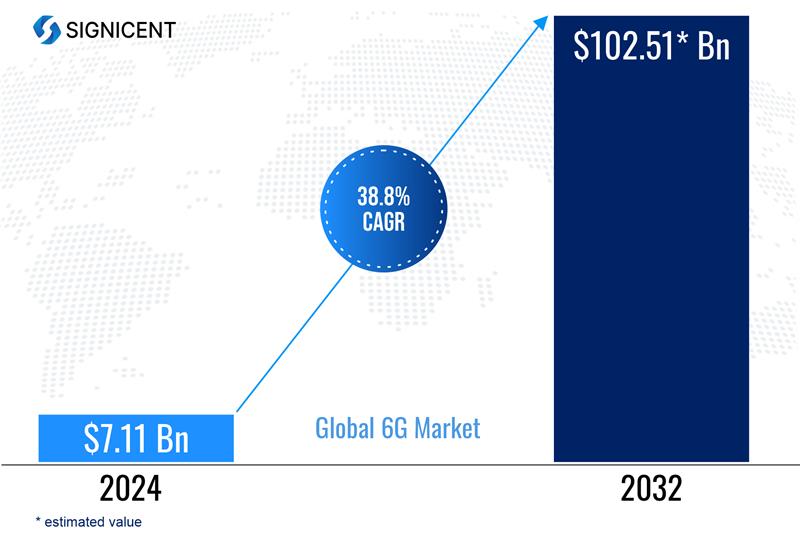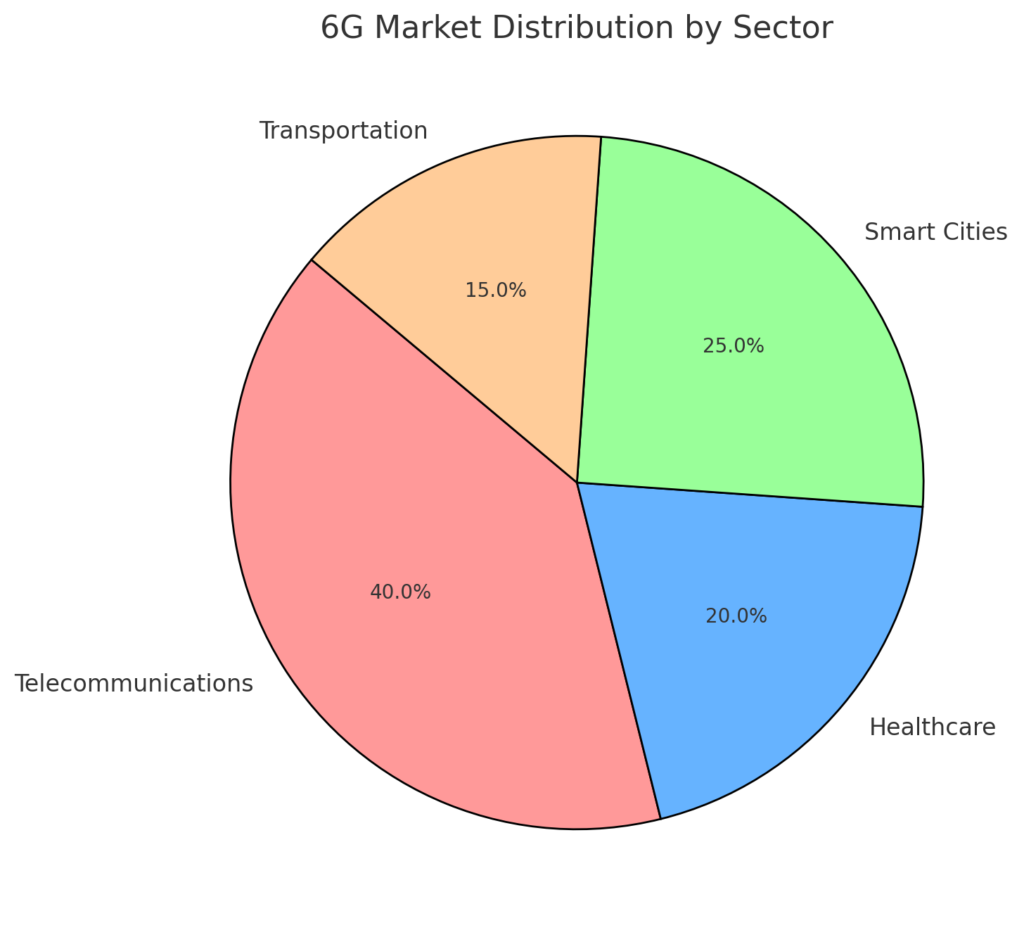Introduction: The Future of Hyper-Connectivity
In today’s rapidly evolving digital landscape, 6G technology is set to redefine global connectivity, pushing the boundaries beyond 5G. With data speeds reaching terabytes per second (Tbps) and latency reduced to just a nanosecond (1ns), it will enable real-time holographic communication, AI-driven automation, and seamless integration of smart cities.
Unlike previous networks, 6G is expected to merge AI, quantum computing, and terahertz (THz) frequencies, unlocking transformative applications across industries. From autonomous transportation to healthcare breakthroughs and immersive Extended Reality (XR), this next-generation network will redefine human interaction with technology. As research accelerates, tech leaders anticipate a future where ultra-fast, intelligent connectivity drives innovation on an unprecedented scale.
This blog explores 6G’s transformative potential, highlighting key breakthroughs that will reshape connectivity, automation, and immersive experiences for the future.
Signicent supports companies with Technology Scouting Services for 6G by identifying cutting-edge breakthroughs, collaborations, and disruptive technologies in telecommunications and wireless networks.
Even though 5G is fast, why does 6G matter for future devices?
The answer lies in patented innovations, 6G isn’t just about speed—it’s about intelligent, immersive, and adaptive connectivity. Companies like Samsung, Huawei, and Nokia are already filing 6G-related patents (over 10,000+ as of 2024), focusing on:
- Holographic Communication: Enabling real-time, 3D holographic meetings and immersive telepresence, revolutionizing remote collaboration and digital interactions.
- Tactile Internet & XR Integration: Providing ultra-low latency touch feedback, enhancing virtual and augmented reality experiences for industries like healthcare and gaming.
- AI-Native Networks & Quantum Security: Creating self-optimizing, energy-efficient networks with quantum encryption, ensuring seamless, secure, and intelligent global connectivity.

Patent Inventions by Leading Companies in 6G Technology
Several tech giants are driving 6G innovation, securing patents to shape the future of connectivity. Here’s how they are leading the race:
- Samsung – Over 2,000+ patents on terahertz (THz) frequency transmission, enabling ultra-fast, high-capacity 6G networks.
- Huawei – More than 3,000+ patents focused on AI-driven 6G optimization, ensuring intelligent and self-sustaining network infrastructure.
- Nokia – Holding 1,500+ patents in wireless spectrum utilization, optimizing frequency efficiency for seamless global coverage.
- Ericsson – Securing 1,200+ patents on holographic communication, revolutionizing real-time virtual interactions and extended reality (XR).
- Apple – With 1,000+ patents, focusing on low-power 6G chips, enhancing IoT, smart wearables, and next-gen mobile experiences.
Signicent assists clients in conducting Patent Landscape Services for 6G innovations, identifying key trends, emerging players, and patent filing strategies worldwide.
Evolution of Mobile Network Generations
Here’s a structured table comparing different wireless generations, including speed, device usage, and key applications:
| Generation (Year) | Max Speed | Speed Per Second | Device Usage | Key Applications |
| 1G (1980s) | 2.4 Kbps | 300 B/sec | Analog mobile phones | Basic voice calls only |
| 2G (1991) | 64 Kbps | 8 KB/sec | Feature phones | SMS, voice calls, basic internet |
| 3G (2001) | 2 Mbps | 250 KB/sec | Early smartphones | Mobile browsing, video calls, MMS |
| 4G (2009) | 100 Mbps | 12.5 MB/sec | Smartphones, tablets, IoT devices | HD streaming, cloud apps, social media |
| 5G (2019) | 10 Gbps | 1.25 GB/sec | Smart devices, IoT, AR/VR headsets | IoT expansion, real-time AR/VR, autonomous vehicles |
| 6G (2030 Expected) | 100+ Gbps | 12.5+ GB/sec | AI-driven devices, XR wearables, holographic displays | Holographic calls, immersive XR, AI automation |
5G vs 6G: The Ultimate Comparison
As the digital landscape evolves, 6G technology is set to redefine real-time interactions, bridging distances with ultra-low latency and AI-powered connectivity. This advancement will unlock seamless, high-fidelity experiences across multiple domains, including:
3D Experience and Future Devices
6G will integrate next-gen immersive experiences, including:
- Holographic telepresence – Enabling lifelike 3D video calls.
- VR/XR (Extended Reality) – Offering ultra-realistic virtual environments.
- AI-enhanced real-time interactions – Facilitating remote work, education, and telemedicine.
Now, 6G is the next leap, promising 100x faster speeds than 5G
| Feature | 5G | 6G (2030+) | Real-Life Impact |
| Speed | Up to 10 Gbps | 1 Tbps (100x faster) | Download 4K movies in milliseconds. |
| Latency | 1-5 ms | Sub-1ms (near-zero) | Remote surgeries with no lag. |
| Frequency | Sub-6GHz, mm Wave | Terahertz (THz) bands | Enables holograms & quantum comms. |
| AI Integration | Limited AI support | Fully AI-driven networks | Self-healing networks & predictive analytics. |
| Key Use Cases | Smartphones, IoT | Smart cities, XR, Digital Twins | Fully autonomous AI-powered societies. |
Limitations of Existing Networks: A Critical Evaluation
Despite continuous advancements, current mobile networks face persistent challenges that restrict seamless connectivity and hinder the scalability required for future technologies:
- Limited Bandwidth (Smart Cities & IoT) – As global data consumption surges, networks struggle to support IoT devices, smart grids, and urban surveillance systems, leading to performance degradation.
- High Latency (Autonomous Vehicles & Remote Surgery) – Delays in data transmission affect self-driving cars’ response times and real-time robotic surgeries, risking safety and operational precision.
- Energy Inefficiency (5G Towers & Industrial Automation) – Power-hungry 5G infrastructure raises operational costs for telecom providers while increasing the carbon footprint of smart factories and AI-driven automation.
- Coverage Gaps (Rural Connectivity & Telemedicine) – Limited network expansion in remote areas restricts access to online education, virtual healthcare consultations, and agricultural smart monitoring systems.
- Security Risks (Financial Transactions & Critical Infrastructure) – Cyberattacks targeting banking systems, cloud networks, and industrial control units pose significant threats to economic stability and national security.
- Infrastructure Costs (Developing Nations & Smart Infrastructure) – The high cost of deploying advanced networks slows adoption, making it difficult for emerging economies to implement smart transportation and connected cities.
Why Do Mobile Networks Keep Evolving?
As our world becomes more digital, the demand for faster, more efficient, and seamless connectivity keeps growing. Each new generation of mobile networks brings innovations that transform how we live and work.
- Rising Data Needs – With 4K streaming, cloud gaming, and AI services on the rise, networks must handle massive data loads.
- Lower Latency – Technologies like self-driving cars, smart factories, and remote surgery rely on split-second response times.
- Smarter Devices – From simple voice calls (2G) to AI-powered smart cities (6G), networks now connect billions of devices.
- Stronger Security – Advanced encryption and AI-driven threat detection protect sensitive data in an increasingly digital world.
- Global Reach – Future networks will bridge connectivity gaps, ensuring reliable service in cities, rural areas, and beyond.
The need for speed, reliability, and innovation keeps driving mobile networks forward—from simple calls in the 2G era to AI-powered automation in the 5G and 6G future.
Signicent provides Technology Gap Analysis in 6G to help businesses understand market voids, R&D opportunities, and competitive differentiation in next-gen communication systems.
Each year Signicent provides consultancy to hundreds of organizations to help transform their innovations to value.
Innovations in Next-Gen Wireless Technology: Transforming Industries
The arrival of 6G will go beyond speed improvements, introducing intelligent, secure, and energy-efficient networks that will redefine industries. Here’s how each innovation will be applied across different sectors, unlocking groundbreaking possibilities.
Key Innovations in 6G Technology & Their Future Applications
1. AI-Powered Self-Optimizing Networks
Future Application: Smart Cities & Industrial Automation
- AI-driven networks will automatically adjust bandwidth and resources based on demand, ensuring uninterrupted connectivity in smart cities.
- In manufacturing, real-time optimization will reduce downtime, making smart factories more efficient.
2. Quantum Communication for Ultra-Secure Data Transfer
Future Application: Healthcare & Finance
- Hospitals will use quantum encryption for secure patient data sharing, eliminating risks of cyber threats.
- Financial institutions will rely on quantum-safe cryptography for unbreakable security in digital transactions and banking services.

3. Advanced Satellite-Based Internet Solutions
Future Application: Rural Connectivity & Global Logistics
- Satellite-powered 6G will bring high-speed internet to remote villages, improving education and healthcare access.
- Logistics companies will use seamless global tracking, reducing shipment delays and enhancing real-time fleet management.
4. Low-Energy Connectivity for IoT and Smart Devices
Future Application: Smart Homes & Agriculture
- Smart homes will have always-on IoT devices with ultra-low power consumption, making automation more energy-efficient.
- Farmers will use AI-powered drones with extended battery life to monitor crops and optimize irrigation.
5. Holographic User Interfaces in Everyday Devices
Future Application: Workplace & Entertainment
- Businesses will conduct holographic meetings, enabling immersive collaboration across different locations.
- Gaming and entertainment will evolve into interactive 3D experiences, offering lifelike virtual reality (VR) environments.
6. 6G-Integrated Healthcare for Real-Time Remote Surgeries
Future Application: Telemedicine & Emergency Response
- Surgeons will perform robotic surgeries remotely with near-zero latency, saving lives in critical situations.
- AI-driven wearable health monitors will instantly alert doctors to patient conditions, improving emergency response times.

How 6G Will Power Satellite Networks
Tech giants like Jio, Airtel, and Starlink are driving 6G-compatible satellite advancements to redefine global connectivity.
- Global high-speed internet – Expanding seamless connectivity across remote areas, oceans, and underserved regions worldwide.
- Low-latency communication – Enabling real-time data exchange for space missions, remote operations, and autonomous technologies.
- AI-powered networks – Optimizing bandwidth allocation for industries, enterprises, and cloud-based applications with smart automation.
Signicent assists clients with Patent Licensing Services in 6G, helping them acquire, monetize, and negotiate essential IP rights for seamless technology deployment.
Benefits of 6G in Future Operations
With 6G-enabled satellites, industries will unlock unmatched connectivity, automation, and security, driving the future of global communication.
- Instant Data Transfers – Terabit-speed connectivity will enable businesses to process and exchange data seamlessly across borders.
- AI-Driven Automation – Smart factories, supply chains, and logistics will leverage AI-powered satellites for real-time optimization.
- Energy Efficiency – Sustainable 6G networks will reduce power consumption, supporting greener and more eco-friendly operations.
- Enhanced Security – Quantum encryption will safeguard sensitive financial, corporate, and government data against cyber threats.
6G Global Market Outlook (2024-2032)
The global 6G technology market is poised for significant expansion in the coming years. As per Signicent Market Research, the market is projected to reach substantial values by 2032, driven by breakthroughs in AI-driven networks, quantum communication, terahertz technology, and the increasing demand for ultra-fast, low-latency, and energy-efficient connectivity solutions.

Signicent provides Market Intelligence for 6G technology, analyzing trends, investment opportunities, and competitive strategies shaping the future of ultra-fast wireless communications.
Global 6G Market Distribution by Sector wise (2024 –2032)
The pie chart highlights the 6G market distribution across key sectors. Telecommunications dominates as the backbone of 6G, driving connectivity and infrastructure advancements. Smart Cities leverage 6G for enhanced urban planning, IoT integration, and real-time data processing. Healthcare benefits from ultra-low latency for telemedicine, remote surgeries, and AI-driven diagnostics. Transportation integrates 6G for autonomous vehicles, smart traffic management, and vehicle-to-everything (V2X) communication, ensuring safer and more efficient mobility solutions.

Global 6G Market Share by Regional Analysis (2024 –2032)
The pie chart illustrates the 6G market share distribution across different regions. Asia-Pacific leads in technological adoption and infrastructure advancements. North America follows with strong investments in research and development. Europe is focusing on regulatory frameworks and industrial collaborations. Latin America is gradually embracing 6G with growing awareness, while the Middle East & Africa show emerging potential, driven by smart city initiatives and digital transformation efforts.

Signicent helps businesses perform FTO Search Services in 6G technology, ensuring innovation commercialization without infringing existing patents in telecom and networking.
Global 6G Market – Mergers and Acquisitions
- Nokia Acquires Quantum Firm (2026): Strengthening cybersecurity with quantum key distribution for secure 6G networks.
- Huawei Partners with Terahertz Tech (2024): Advancing high-speed data transmission with Terahertz communication solutions.
- Ericsson Invests in HoloComm (2025): Enhancing 6G holographic communication for immersive digital experiences.
- Samsung & Quantum Innovations Lab (2025): Driving quantum-secure communication for next-gen private and secure 6G networks.
- Qualcomm Acquires ChipTech (2027): Expanding 6G chipset portfolio to lead advanced wireless communication technology.
- Intel & Terahertz Research Institute (2026): Pioneering ultra-fast data transfer through terahertz communication innovations.
If you are exploring advancements in 6G technology and its applications, feel free to reach out to us. We provide in-depth analysis and expert services in 6G technology landscape, market trends, and innovation gaps.
Our research-driven approach helps in identifying key opportunities and strategic solutions for seamless connectivity, AI-driven automation, and secure communication in the evolving 6G ecosystem.
Top Companies Leading the 6G Market
6G is shaping the future of connectivity, with key players driving innovation in ultra-fast, AI-powered networks.
In addition to Nokia, Huawei, Samsung Electronics, Ericsson and Qualcomm, other notable companies actively engaged in 6G technology development include:
Signicent: Driving Future Innovations for Startups & Industry Leaders
Signicent has empowered global startups and leading corporations with cutting-edge research, white space analysis, and technology gap identification. Our expertise in innovation scouting and market intelligence helps businesses stay ahead in emerging technologies like 6G, AI, quantum communication, and sustainable solutions.
Having assisted clients across various industries and countries, Signicent provides strategic insights that fuel breakthrough innovations, optimize R&D investments, and accelerate market adoption. Whether you’re a startup seeking disruptive opportunities or an industry giant refining your technological edge, Signicent ensures your innovation roadmap is future-ready.
Conclusion: Is 6G the Future?
6G will redefine global connectivity with its ultra-fast speeds, AI-driven automation, and quantum-secure networks. Industries will experience seamless data exchange, real-time holographic communication and intelligent automation, transforming healthcare, manufacturing, and smart cities. With near-zero latency and energy-efficient designs, 6G will drive sustainability while unlocking new possibilities in immersive experiences and autonomous systems. As leading players invest in cutting-edge research, the evolution of 6G will foster unprecedented advancements, making hyper-connected, intelligent ecosystems a reality. The future isn’t just about faster networks—it’s about smarter, more secure, and deeply integrated digital transformation.
6G Technology Market: FAQ’s
- How is 6G different from 5G?
Think of 5G as a highway, and 6G as teleportation! It’s way faster, smarter, and built for AI-driven experiences.
- Which countries are leading the 6G race?
China, the U.S., Japan, and South Korea are going all-in on 6G, aiming to dominate global connectivity by 2030.
- How will 6G change smart cities and IoT?
Imagine cities where traffic, healthcare, and security respond instantly—6G will make IoT seamless, powering the smartest cities we’ve ever seen.
- What are the biggest hurdles in launching 6G?
Tech challenges, crazy infrastructure costs, security concerns, and global regulations—getting 6G off the ground won’t be easy, but it’s coming.
- What role will AI and quantum computing play in 6G?
AI will make networks self-learning, while quantum computing will bring hack-proof security. Together, they’ll redefine how we connect and communicate.
- When can we expect 6G to go mainstream?
2028–2030 is the target, but early experiments are already happening. The future of ultra-fast, intelligent networks is closer than you think!
About Signicent LLP
We assist businesses globally in their technology innovations, R&D, new product development, patents, valuation, product commercialization & market research needs.
Services Offered:
- Patent Landscape
- Patent Portfolio Analysis
- Patent Invalidity Search
- Patent Licensing Services
- Freedom to operate (FTO)
- Chemical Structure Search
- Design Patent Search
- Technology Scouting
- Technology Landscape Analysis
- Technology gap analysis
- Technology Intelligence
- Market Research
- Bio Sequence Search
- Manufacturers Search/ Supplier search
Elevate your Innovation and Research with Signicent’s cutting edge approach to assist you with Technology and Market related matters alongside the IP aspect of the analysis.


